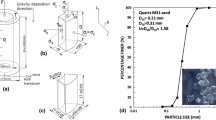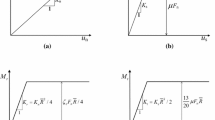Abstract
By incorporating the fabric effect and Lode’s angle dependence into the Mohr–Coulomb failure criterion, a strength criterion for cross-anisotropic sand under general stress conditions was proposed. The obtained criterion has only three material parameters which can be specified by conventional triaxial tests. The formula to calculate the friction angle under any loading direction and intermediate principal stress ratio condition was deduced, and the influence of the degree of the cross-anisotropy was quantified. The friction angles of sand in triaxial, true triaxial, and hollow cylinder torsional shear tests were obtained, and a parametric analysis was used to detect the varying characteristics. The friction angle becomes smaller when the major principal stress changes from perpendicular to parallel to the bedding plane. The loading direction and intermediate principal stress ratio are unrelated in true triaxial tests, and their influences on the friction angle can be well captured by the proposed criterion. In hollow cylinder torsional shear tests with the same internal and external pressures, the loading direction and intermediate principal stress ratio are related. This property results in a lower friction angle in the hollow cylinder torsional shear test than that in the true triaxial test under the same intermediate principal stress ratio condition. By comparing the calculated friction angle with the experimental results under various loading conditions (e.g., triaxial, true triaxial, and hollow cylinder torsional shear test), the proposed criterion was verified to be able to characterize the shear strength of cross-anisotropic sand under general stress conditions.





















Similar content being viewed by others
References
Abelev AV, Lade PV (2003) Effects of cross anisotropy on three-dimensional behavior of sand. I: stress-strain behavior and shear banding. J Eng Mech ASCE 129(2):160–166
Abelev AV, Lade PV (2004) Characterization of failure in cross-anisotropic soils. J Eng Mech ASCE 130(5):599–606
Abelev AV, Gutta SK, Lade PV, Yamamuro JA (2007) Modeling cross anisotropy in granular materials. J Eng Mech ASCE 133(1):919–932
Arthur J, Menzies B (1972) Inherent Anisotropy in Sand. Géotechnique 22(1):115–128
Arthur J, Phillips A (1975) Homogeneous and layered sand in triaxial compression. Géotechnique 25:799–815
Bardet JP (1990) Lode dependences for pressure-sensitive isotropic elastoplastic materials. J Appl Mech ASME 57(3):498–506
Bishop AW (1966) The strength of soils as engineering materials. Géotechnique 16(2):91–130
Chang CS, Bennett K (2015) Micromechanical modeling for the deformation of sand with noncoaxiality between the stress and material axes. J Eng Mech ASCE. doi:10.1061/(ASCE)EM.1943-7889.0000966
Chang CS, Hicher PY (2005) An elastic–plastic model for granular materials with microstructural consideration. Int J Solids Struct 42:4258–4277
Chang CS, Yin Z-Y (2010) Micromechanical modeling for inherent anisotropy in granular materials. J Eng Mech ASCE 136(7):830–839
Chang J, Chu X, Xu Y (2014) Finite-element analysis of failure in transversely isotropic geomaterials. Int J Geomech ASCE. doi:10.1061/(ASCE)GM.1943-5622.0000455
Dafalias Y, Papadimitriou A, Li X (2004) Sand plasticity model accounting for inherent fabric anisotropy. J Eng Mech (ASCE) 130(11):1319–1333
Gao Z, Zhao J (2012) Efficient approach to characterize strength anisotropy in soils. J Eng Mech ASCE 138(12):1447–1456
Gao ZW, Zhao JD, Yao YP (2010) A generalized anisotropic failure criterion for geomaterials. Int J Solids Struct 47:3166–3185
Guo P, Stolle DFE (2005) On the failure of granular materials with fabric effects. Soils Found 45(4):1–12
Haruyama M (1981) Anisotropic deformation-strength properties of an assembly of spherical particles under three dimensional stresses. Soils Found 21(4):41–55
Huang MS, Lu XL, Qian JG (2010) Non-coaxial elasto-plasticity model and bifurcation prediction of shear banding in sands. Int J Numer Anal Meth Geomech 34(9):906–919
Kong Y, Zhao J, Yao Y (2013) A failure criterion for cross-anisotropic soils considering microstructure. Acta Geotech 8(6):665–673
Kumruzzaman M, Yin J-H (2010) Influence of the intermediate principal stress on the stress–strain–strength behaviour of a completely decomposed granite soil. Can Geotech J 47(2):164–179
Lade PV (2006) Assessment of test data for selection of 3-D failure criterion for sand. Int J Numer Anal Meth Geomech 30(4):307–333
Lade PV (2008) Failure criterion for cross-anisotropic soils. J Geotech Geoenviron Eng ASCE 134(1):117–124
Lade PV, Abelev AV (2003) Effects of cross anisotropy on three-dimensional behavior of sand. II: volume change behavior and failure. J Eng Mech ASCE 129(2):167–174
Lade PV, Nam J, Hong WP (2008) Shear banding and cross-anisotropic behaviour observed in laboratory sand tests with stress rotation. Can Geotech J 45:74–84
Lade PV, Rodriguez NM, Dyck EJV (2014) Effects of principal stress directions on 3D failure conditions in cross-anisotropic sand. J Geotech Geoenviron Eng ASCE 140:04013001-1
Li XS, Dafalias YF (2002) Constitutive modeling of inherently anisotropic sand behavior. J Geotech Geoenviron Eng ASCE 128(10):868–880
Liu MD, Indraratna BN (2011) General strength criterion for geomaterials including anisotropic effect. Int J Geomech ASCE 11(3):251–262
Lu XL, Huang MS, Qian JG (2011) The onset of strain localization in cross-anisotropic soils under true triaxial condition. Soils Found 51(4):693–700
Ma Z, Liao H, Dang F (2014) Influence of intermediate principal stress on the bearing capacity of strip and circular footings. J Eng Mech ASCE 140(7):04014041
Matsuoka H, Nakai T (1974) Stress-deformation and strength characteristics of soil under three different principal stress. Proc JSCE 232:59–70
Mortara G (2010) A yield criterion for isotropic and cross-anisotropic cohesive-frictional materials. Int J Numer Anal Meth Geomech 34(9):953–977
Ochiai H, Lade PV (1983) Three-dimensional behaviour of sand with anisotropic fabric. J Geotech Eng ASCE 109(10):1313–1328
Oda M (1972) Initial fabrics and their relations to mechanical properties of granular material. Soils Found 12(1):17–36
Oda M, Koishikawa I, Higuchi T (1978) Experimental study of anisotropic shear strength of sand by plane strain test. Soils Found 18(1):25–38
Oda M, Iwashita I, Kazama H (1997) Micro-structure developed in shear bands of dense granular soils and its computer simulation-mechanism of dilatancy and failure. In: IUTAM symposium on mechanics of granular and porous materials. Kluwer Academic Publishers, Dordrecht
Pietruszczak S, Mroz Z (2000) Formulation of anisotropic failure criteria incorporating a microstructure tensor. Comput Geotech 26(2):105–112
Pietruszczak S, Mroz Z (2001) On failure criteria for anisotropic cohesive-frictional materials. Int J Numer Anal Meth Geomech 25(5):509–524
Rodriguez NM, Lade PV (2013) True triaxial tests on cross-anisotropic deposits of fine Nevada sand. Int J Geomech ASCE 13(6):779–793
Sun YF, Liu HL, Yang G, Xiao Y (2013) Formulation of cross-anisotropic failure criterion for soils. Water Sci Eng 6(4):456–468
Symes MJ, Gens A, Hight DW (1988) Drained principal stress rotation in saturated sand. Géotechnique 38(1):59–81
Willam KJ, Warnke EP (1975) Constitutive model for the triaxial behavior of concrete. In: International association for bridge and structure engineering proceedings. Bergamo, Italy
Wu W (1998) Rational approach to anisotropy of sand. Int J Numer Anal Meth Geomech 22(11):921–940
Yamada Y, Ishihara K (1979) Anisotropic deformation characteristics of sand under three-dimensional stress conditions. Soils Found 19(2):79–94
Yang LT, Li X, Yu HS, Wanatowski D (2015) A laboratory study of anisotropic geomaterials incorporating recent micromechanical understanding. Acta Geotech. doi:10.1007/s11440-015-0423-7
Yao Y, Hu J, Zhou A, Luo T, Wang N (2015) Unified strength criterion for soils, gravels, rocks, and concretes. Acta Geotech 10(6):749–759
Zhao J, Guo N (2015) The interplay between anisotropy and strain localisation in granular soils: a multiscale insight. Géotechnique 65(8):642–656
Acknowledgments
The financial supports by National Basic Research Program of China (through Grant No. 2014CB049100, 2012CB719803) and National Science Foundation of China (NSFC through Grant No. 11372228) are gratefully acknowledged. We are grateful to the anonymous reviewers for their helpful comments and suggestions.
Author information
Authors and Affiliations
Corresponding author
Rights and permissions
About this article
Cite this article
Lü, X., Huang, M. & Andrade, J.E. Strength criterion for cross-anisotropic sand under general stress conditions. Acta Geotech. 11, 1339–1350 (2016). https://doi.org/10.1007/s11440-016-0479-z
Received:
Accepted:
Published:
Issue Date:
DOI: https://doi.org/10.1007/s11440-016-0479-z




